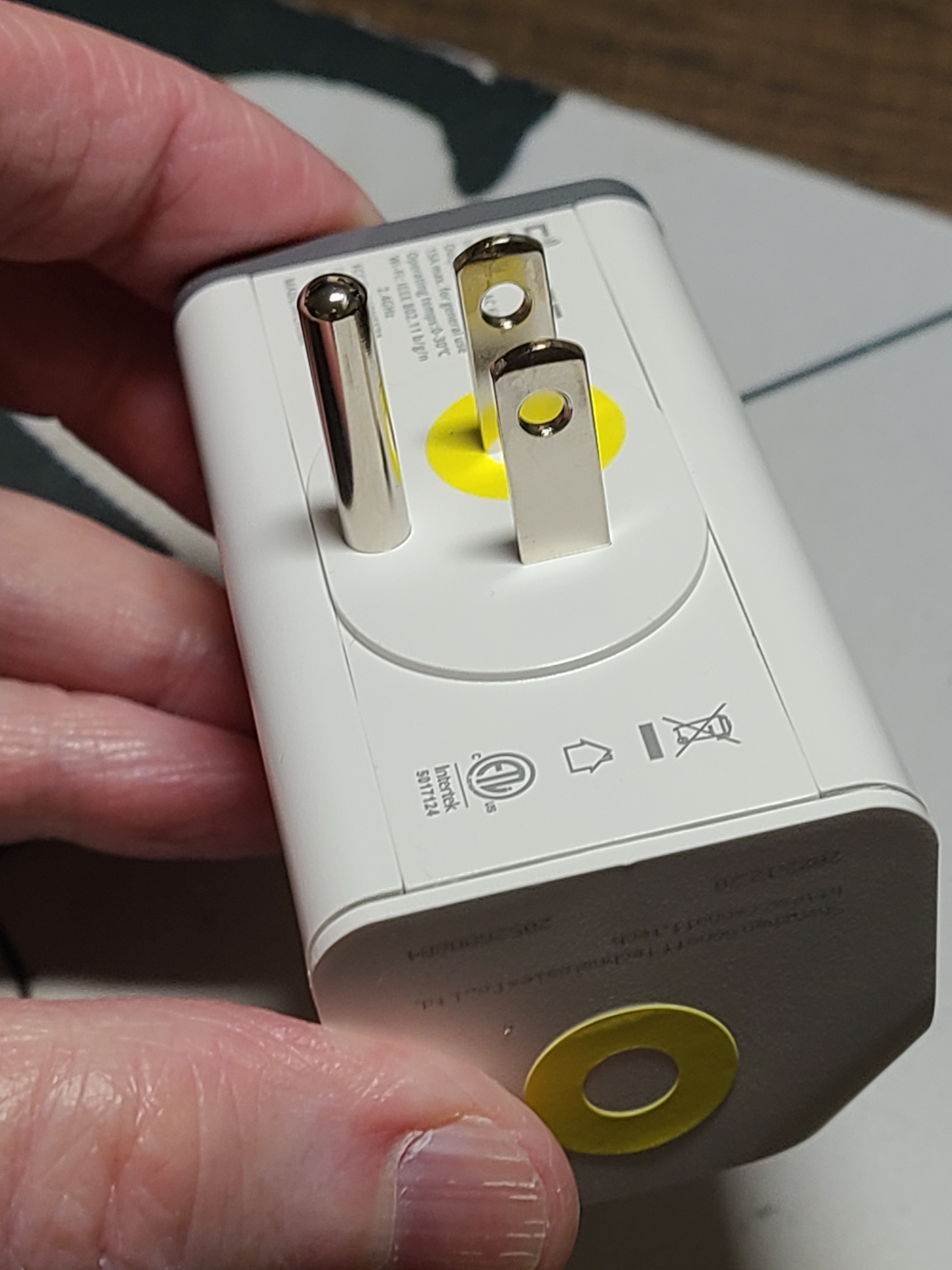I marked all of my S31 devices with different colors so I could keep track of what was what. I have green, pink, yellow, and orange markings. Here's the yellow one:

I then set about making some initial changes to the ESPHome sample configuration. This will probably evolve a little bit over time. There are already some changes I'm planning to make.
I used a common configuration file that gets included into a configuration file specific to each separate device. For example, here is the one for the yellow S31:
substitutions:
name: s31yellow
alias: Yellow
alias_icon: mdi:cloud-question
power_on_boot: 'true'
<<: !include { file: s31.yaml.inc}
The idea of the substitution variables is to control configuration of things in the common file, which is here:
# This is a mild adaptation of the ESPHome configuration for Sonoff S31
# smart plug described here: https://www.esphome-devices.com/devices/Sonoff-S31/
# Pin Function
# GPIO0 Push Button (HIGH = off, LOW = on)
# GPIO12 Relay and its status LED
# GPIO13 Green LED (HIGH = off, LOW = on)
# GPIO1 RX pin (for external sensors)
# GPIO3 TX pin (for external sensors)
# This file is intended to be included from another file that defines
# some configuration choices via substitution variables:
# name: the name of this device, appears various places
# alias: a functional alias, reported as a text sensor
# alias_icon: front-end icon for the alias sensor
# power_on_boot: boolean, whether to turn on the relay at boot time
esphome:
name: ${name}
platform: ESP8266
board: esp01_1m
on_boot:
then:
- text_sensor.template.publish:
id: i_alias
state: ${alias}
- if:
condition:
lambda: 'return ${power_on_boot};'
then:
- switch.turn_on: relay
# give time for all the status goop to stop fiddling with the LED
- delay: 60s
- light.turn_off: i_status_led
wifi:
ssid: !secret wifi_ssid
password: !secret wifi_password
logger:
baud_rate: 0 # (UART logging interferes with cse7766)
api:
ota:
# The value never changes except on a firmware update,
# so the update interval is never, and the value is
# published at boot time.
text_sensor:
- platform: template
name: "${name} alias"
id: i_alias
icon: ${alias_icon}
update_interval: never
uart:
rx_pin: RX
baud_rate: 4800
binary_sensor:
- platform: gpio
pin:
number: GPIO0
mode: INPUT_PULLUP
inverted: True
name: "${name} Button"
on_press:
- switch.toggle: relay
- platform: status
name: "${name} Status"
sensor:
- platform: wifi_signal
name: "${name} WiFi Signal"
update_interval: 120s
- platform: cse7766
update_interval: 30s
current:
name: "${name} Current"
accuracy_decimals: 1
voltage:
name: "${name} Voltage"
accuracy_decimals: 1
power:
name: "${name} Power"
accuracy_decimals: 1
energy:
name: "${name} Energy"
accuracy_decimals: 1
switch:
- platform: gpio
name: "${name} Relay"
pin: GPIO12
id: relay
# I changed this from a status_led component to a ligth component
# so that I could control it independently of the boring status.
# "inverted" so that it's normall off.
light:
- platform: status_led
id: i_status_led
name: "${name} Status LED"
pin:
number: GPIO13
inverted: true
Most of this is just taken from the sample. The two most important changes are:
- I wanted to be able to control whether the outlet was switched on at boot time. For the laundry machines, the answer is yes. For some other scenarios, the answer could be no.
- I wanted to be able to use the status LED for my own nefarious purposes (which I have not yet decided). I made sure it was turned off at boot time.
Another minor change was to expose the "energy" sensor, which was not present in the sample for whatever reason.
 WJCarpenter
WJCarpenter
Discussions
Become a Hackaday.io Member
Create an account to leave a comment. Already have an account? Log In.